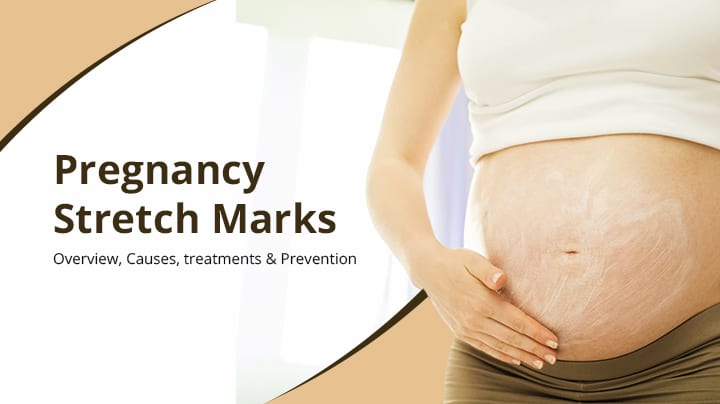
Table of Contents
Pregnancy stretch marks are the classiac way of a baby leaving its imprint on a mother even before birth. While some mothers exhibit indifference towards stretch marks, some mothers swear they could do better without it. Stretch marks, just like anything else, is a matter of personal choice and there should be no one telling you otherwise- you like it or not; your body, your choice!
When do stretch marks start to show during pregnancy ?
Typically, stretch marks can begin to be more obviously visible anytime between week 13th to week 21st of pregnancy. While there could be some women who do not experience stretch marks as severe and as noticeable, most women do show these wave-like lines in colors like pink, red, yellow, tan, or sometimes purplish or brown. Also called “Striae Distensae” or “Striae Gravidarum.” stretch marks, unlike popular misbelief, can occur across
butt, thighs, hips, or breasts – and not just across the belly.
Why do stretch marks occur during pregnancy?
Stretch marks essentially are tears in the supporting layers of the tissue underneath the skin. These tears occur in the skin as, during pregnancy, it is pulled tight to the limit as the skin expands to make room for the baby inside.
Pregnancy stretch marks also have a lot to do with your genes. So, most likely, if your mother had it, you are going to have them too. Besides, obviously, the sudden weight gain during pregnancy also majorly contributes to the occurrence of stretch marks. But as a final word, if you are a mother a little too worried about stretch marks, there’s good news! Stretch marks are not forever and they WILL fade over time into a pale silver or white.
How Can I Prevent Pregnancy Stretch Marks?
As said, pregnancy stretch marks fade over time but if you still are looking for ways to avoid them in the first place, there could be some viable solutions. While there are tons of anti-stretch-mark drugstore treatments available in the market, including Bio-Oil, Palmer’s Cocoa Butter Massage Lotion, and Burt’s Bees Mama Bee Belly Butter, one of the most acclaimed methods to prevent stretch marks is to gain pregnancy weight slowly and steadily. However, it is also necessary to make sure that you do this in a healthy manner. Consult your doctor and ask for a nutritious diet that can help you achieve this goal.
Some other ways to prevent the occurrence of stretch marks include-
- Moisturization
Pregnancy stretch marks can be annoyingly itchy and dry. Though moisturizing daily might not act as a fool-proof cure to avoid stretch marks, it can at least supply moisture and help the stretched, itchy, and dry skin feel comfortable and soft!
- Vitamin C
Eating food rich in Vitamin C can also help since vitamin C nourishes the skin at a molecular level, keeping the skin toned and less vulnerable to marks.
How To Treat Pregnancy Stretch Marks?
Before you get to the list of treatments for pregnancy marks, it should be noted here that most treatments can only help lessen the appearance of pregnancy marks. As much as we’d wish you to, there aren’t any 100% acclaimed products (none that we know of at least) to magically blur pregnancy stretch marks.
Having said that, here are some treatments that can help lessen pregnancy stretch marks-
- Retinoid cream
A vitamin-A-based topical application solution, Retinoid creams can help minimize the appearance of fresh stretch marks. It does so by rebuilding the collagen in your skin.
- Glycolic acid
Glycolic acid creams and chemical peels can also help reduce the appearance of stretch marks but there is some catch to it. A) It is expensive and it is usually not covered under insurance, being a cosmetic treatment B) They only reduce the occurrence of present marks and do not avoid new ones from occurring whatsoever.
- Laser therapy
Laser therapy essentially stimulates the collagen or elastin under the skin, causing a boosted replenishment.
Regardless of what treatments you want to choose, it is always recommended to make a decision post visiting a skin doctor and taking their consultation into consideration. Especially for retinoid creams, ensure that you speak with your doctor as there has been quite an argument about the application of retinoid, in terms of safety associated concerns, during pregnancy or while nursing.
Pregnancy Stretch Marks Final Conclusion
Before we sum up, let us quickly address another possible question in your mind right now: When can one expect the pregnancy stretch marks to go away?
The time taken for pregnancy stretch marks to go away varies from woman to woman. They will definitely be around for quite a few months and will be more obviously noticeable post-delivery. We are talking about an easy, minimum of six weeks for the uterus to revert back to its old size, which will decrease the size of your belly and then, eventually, diminishing the appearance of stretch marks. However, as said before, we will say this again: stretch marks aren’t forever! Look at them as your baby’s first gift to you and treat ‘em with love and pride for as long as they exist!





